Joanie 4 Jackie was an underground film network formed by artist Miranda July in 1995. For more than a decade this project fomented a generation of female-identified filmmakers—inspiring girls to make movies for the first time, circulating work by seasoned artists to places their distributors and gallerists couldn’t reach, documenting films that hadn’t yet been made, and connecting people across the country through booklets of letters that arrived with each videotape. By the time the project had run its course the work of over 200 filmmakers was distributed through 22 compilation tapes, and Joanie 4 Jackie exhibited from Vancouver to Monterrey to Ljubljana in spaces from punk clubs to the Museum of Modern Art.
The J4J archive, consisting of video tapes, fliers, personal correspondence, grant applications, research notes, press materials, and other ephemera, was just acquired by The Getty Research Institute.
I first encountered Miranda July’s strangely compelling performances in 1995 as part of the short-lived CeBe Barnes Band, at the L.A. Riot Grrrl Convention organized by friends and fellow teen grrrls Sam Dabiri and Leyla Safai. A couple years later I attended a Joanie 4 Jackie (then called Big Miss Moviola) screening at Dumba, a now-defunct queer art collective in a dim warehouse in Brooklyn (see image above). There Miranda encouraged audience members to record themselves with a video camera she set up in the bathroom, completing the sentence, “Nobody ever told me…” (video 1 below).
The evening ended with the private recordings that accumulated over the course of the night projected large, creating a sudden intimacy with the strangers in the room as we shared our secrets and revelations. A few months later I started an experimental film series while an art student at Pratt Institute, and invited Miranda back to New York to present selections from the J4J Chainletter tapes—wild and unpredictable assemblies of woman made movies circulated via post.
By 2000 we’d done two screenings together (see images 2 and 3 below), both greeted by large and eager audiences, and Miranda asked me to curate a videotape in Joanie 4 Jackie’s new Co-Star Series, following compilations put together by herself and now-LACMA curator Rita Gonzalez. After I graduated, Miranda and I trekked down the West Coast with my Some Kind of Loving program (see image 4 below) and a sketch of her upcoming performance, The Swan Tool, to regional art spaces, microcinemas, festivals, and colleges (see 5, 6, and 7 below).
This was my first time touring with another person. When the turnout was meager at a small community space, Miranda cheerfully said backstage, “We’ll still give it our all—it’s like practicing for the next show!” Two days later I had stage fright as hundreds of people waited for me to speak at the grand and balconied Capitol Theater in Olympia. I hustled to get the tape sold on consignment to museum stores, bookstores, and video rental and record stores across New York City (see image 8), as I worked as an independent curator and traveled regularly with other programs of film, video, live music, performance, and mini exhibitions. Years went by, and Miranda passed the Joanie 4 Jackie project on to Bard College to focus on her own feature filmmaking, and I went on to direct gallery spaces.
In 2013 I co-curated an exhibition with Ceci Moss that looked at the impact of the Riot Grrrl movement on cultural producers working today, and featured Miranda July among several artists. Many of the projects in Alien She (see image 9 below) attested to the artists’ long histories of nurturing alternative communities and creating information-sharing networks, such as Joanie 4 Jackie, which was represented by videos, posters, booklets, and personal letters.
At the conclusion of Alien She’s two-year tour we mailed all of the J4J items to the Getty, where Miranda was arranging a donation of the archive. I had kept many of my notes and ephemera from my time with J4J and added them to the collection. In 2016, I started working on the new Joanie 4 Jackie website (begun by Miranda with Vanessa Haroutunian and her fellow Bard students several years earlier), digitizing documents, annotating images, tracking down past participants, creating a timeline of past events, researching details, and organizing the website and materials.
It’s taken a village, and we are thrilled that this labor of love is now being preserved by the Getty Research Institute, accessible to all, and contextualized amongst other important artist and video archives. This project comes out of feminist resistance and grassroots networking—tactics that continue to be valuable and urgent now.
Throughout the last twenty years, my relationship to Joanie 4 Jackie has evolved from spectator to fan, consumer, event programmer, tour booker, distributor, historian, and curator. Below is a selection of artifacts spanning this time, now available along with the complete archive at joanie4jackie.com.
1—Nobody Ever Told Me, 1997
Video made by Miranda July and audience members in the bathroom of the SPRGRL Conspiracy Convention, Portland State University, Portland, Oregon, June 1996.
Joanie 4 Jackie was sprung upon crowds at underground music shows as an disarmingly simple invite: Miranda July would take the stage (or the front of the room) and petition girls and women to send her a video in the mail. In return, she promised, you’d get a VHS tape back with nine other movies.
This was a new experience (in a time when video recording and editing couldn’t take place easily and quickly on phones), which made moviemaking seem astonishingly immediate and personal.
2—Schedule and Setup Diagram for a Joanie 4 Jackie Show, 1998

Event schedule and setup diagram for Big Miss Moviola (Joanie 4 Jackie), a performance by Miranda July, and a music set by Octant at Pratt Film Series, October 30, 1998. Drawn by July and faxed to Suparak at Pratt. From the collection of Astria Suparak
I was just one of the students who struck up correspondences with Miranda and booked Joanie 4 Jackie shows at our colleges. The scrappy DIY attitude and the alternative nature of the project spoke to us, as did the mesmerizing performances of Miranda’s that accompanied the screenings.
Miranda was the second guest artist I hosted at the Pratt Film Series, and I’m sure her technical requirements lists, setup diagrams, and discussion of fees helped me to better understand how to work with artists and organize live performance and music (I was 19 at the time and learning everything as I went along). Joanie 4 Jackie was another pool of artists I could research from in these pre-Wikipedia, pre-YouTube days before all artists had their own websites and video streamed easily online, along with the many screenings and events I attended throughout New York City, the catalogues I pored over from film and video distributors, and the works I read about in The Village Voice, textbooks, and other publications.
Note the gaffer tape at top; this sheet was probably taped to the wall of the lecture hall while the Pratt Film Series crew set up for the event.
3—Flier for a Joanie 4 Jackie Show, 1998
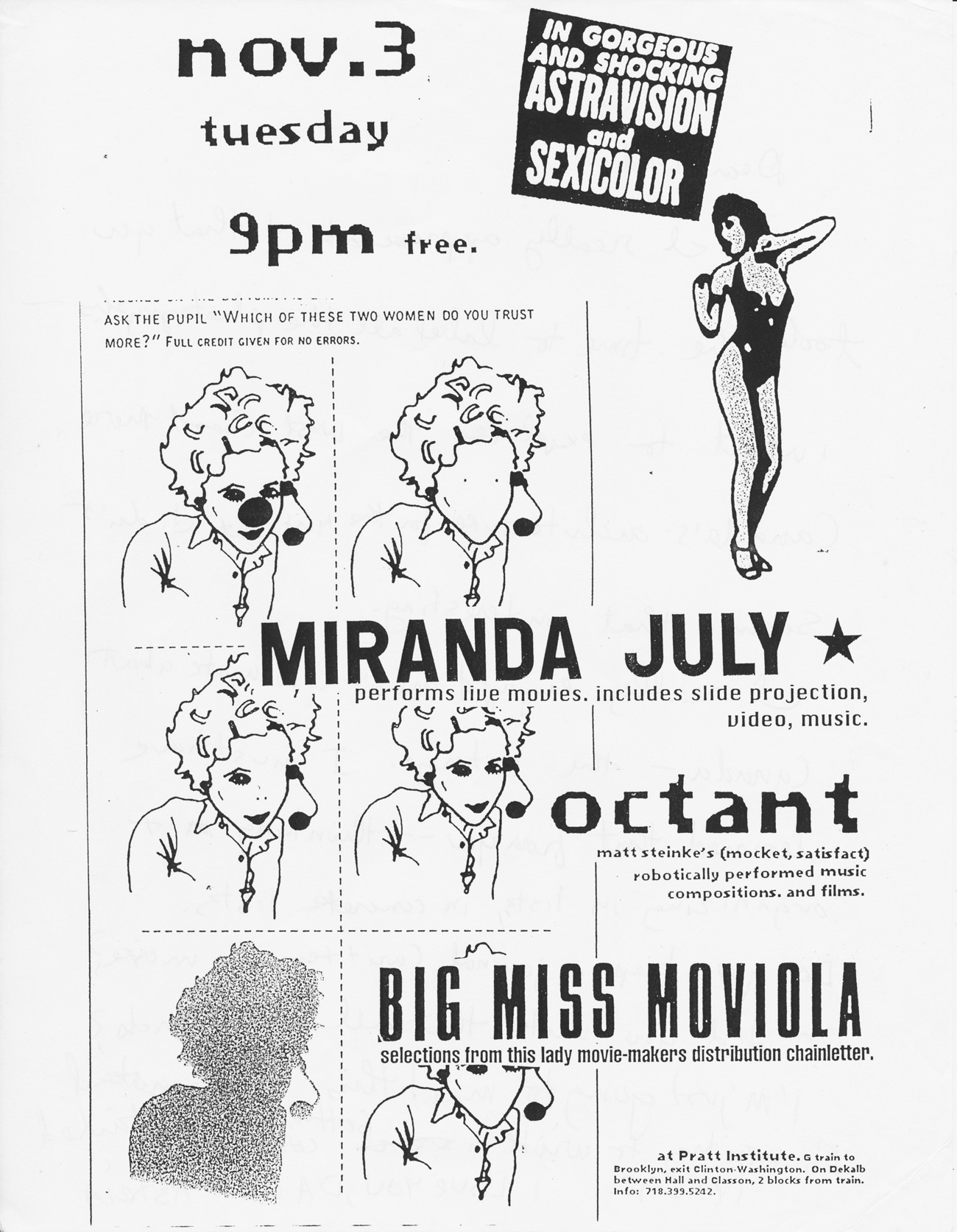
Poster for Big Miss Moviola, Miranda July, and Octant at Pratt Films, November 3, 1998. Xeroxed flier. Designed by Astria Suparak with images from July’s CD insert from The Binet-Simon Test (1998). From the collection of Astria Suparak
My programming for the Pratt Film Series reflected my interests in experimental work (as an anti-mainstream-everything punk), cross-disciplinary programming (as a curious student feeling stifled in a traditionally siloed art school), and feminist and queer artists (as a person needing to see visions and voices closer to mine than the endless parade of white male filmmakers dominating Hollywood and art houses). I saw the film series as a way to create my own education as well as a way to forefront the politics and voices I wanted to see in the world. This attitude and determination came from my experiences as a teenager in the do-it-yourself feminist movement Riot Grrrl—the same milieu in which Miranda brought forth Joanie 4 Jackie at 21 years old.
I posted the fliers I made (initially cut-and-paste, like this one) around campus and in music clubs, cinematheques, and stores around New York City.
4—Some Kind of Loving Compilation, 2000
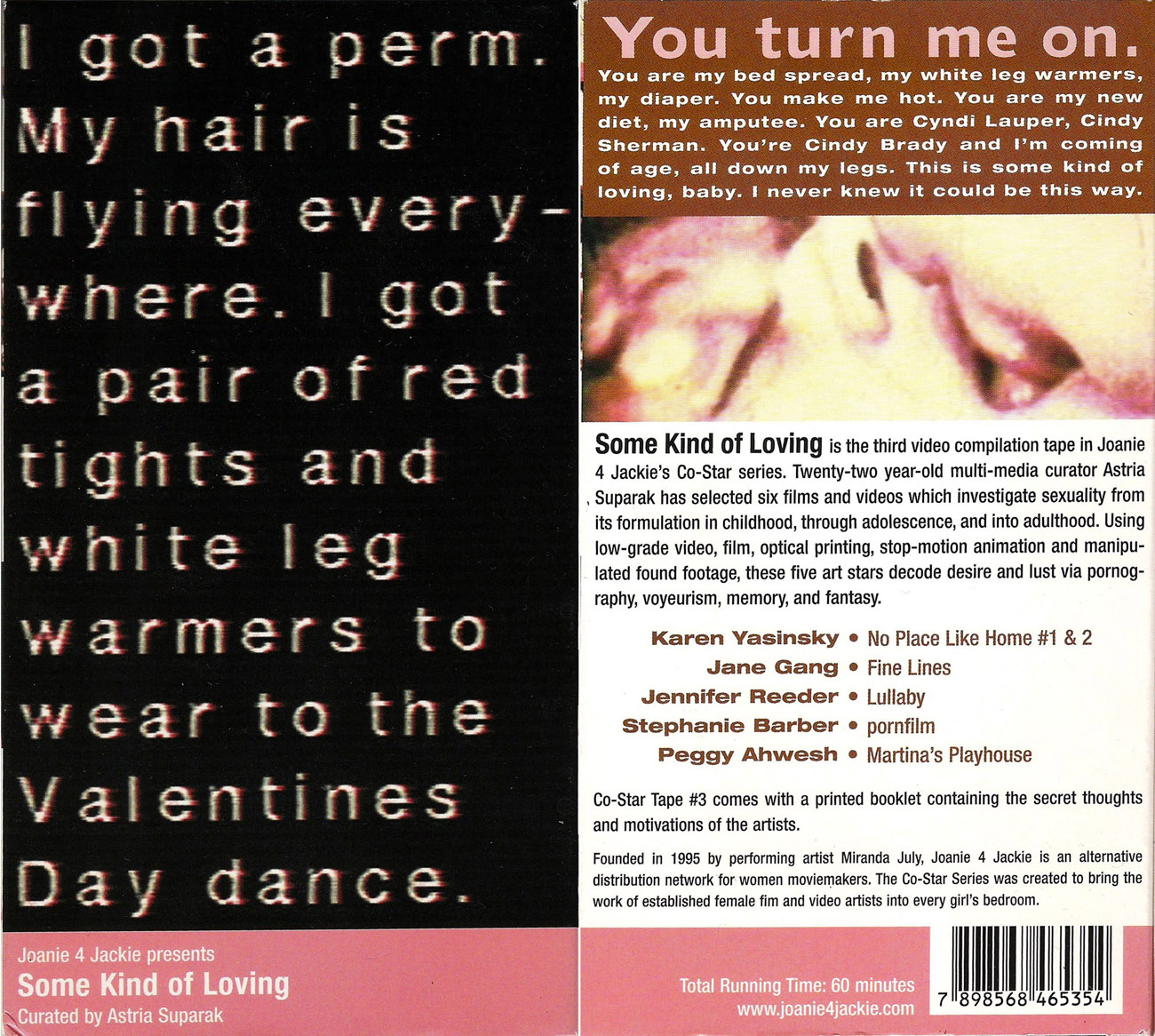
Some Kind of Loving videotape box cover (front and back), 2000. Curated by Astria Suparak and designed by Miranda July, with a still from a video by Jennifer Reeder on front and from a film by Stephanie Barber on back.
No Place Like Home #2 from Karen Yasinsky on Vimeo.
“No Place Like Home #2,” digital film by Karen Yasinsky, 1999.
Different from the Chainletters, the Co-Star Tapes were selected videos put together by young feminist curators. In total there were three tapes in the series, curated by Miranda July, Rita Gonzalez, and myself. I took this opportunity to speak to the unique fanbase Joanie 4 Jackie had built up: Teenage girls ordering tapes by mail and watching them in the privacy of their own homes.
I wanted to share visions made by women that didn’t match the bland images of hetero romance that teens saw on television and in movie theaters at that time. I made a tape of awkwardness, trauma, conflicted women, cunnilingus, unshaved pussy, listlessness, failed marriages, and child-initiated explorations of sexuality. And I selected work made on tiny budgets, whose means of production were more accessible than those at the movie theater: home videos slowed down, hand-sewn dolls animated through stop-motion, scratched film, found footage, and humble Super-8.
5—Email with Tech Requirements for the Some Kind of Loving Tour, 2000

Page 1 of an e-mail with technical requirements and press materials, written by Astria Suparak to venues on the Some Kind of Loving tour, 2000. From the collection of Astria Suparak
6—Tour Poster for Some Kind of Loving, 2000
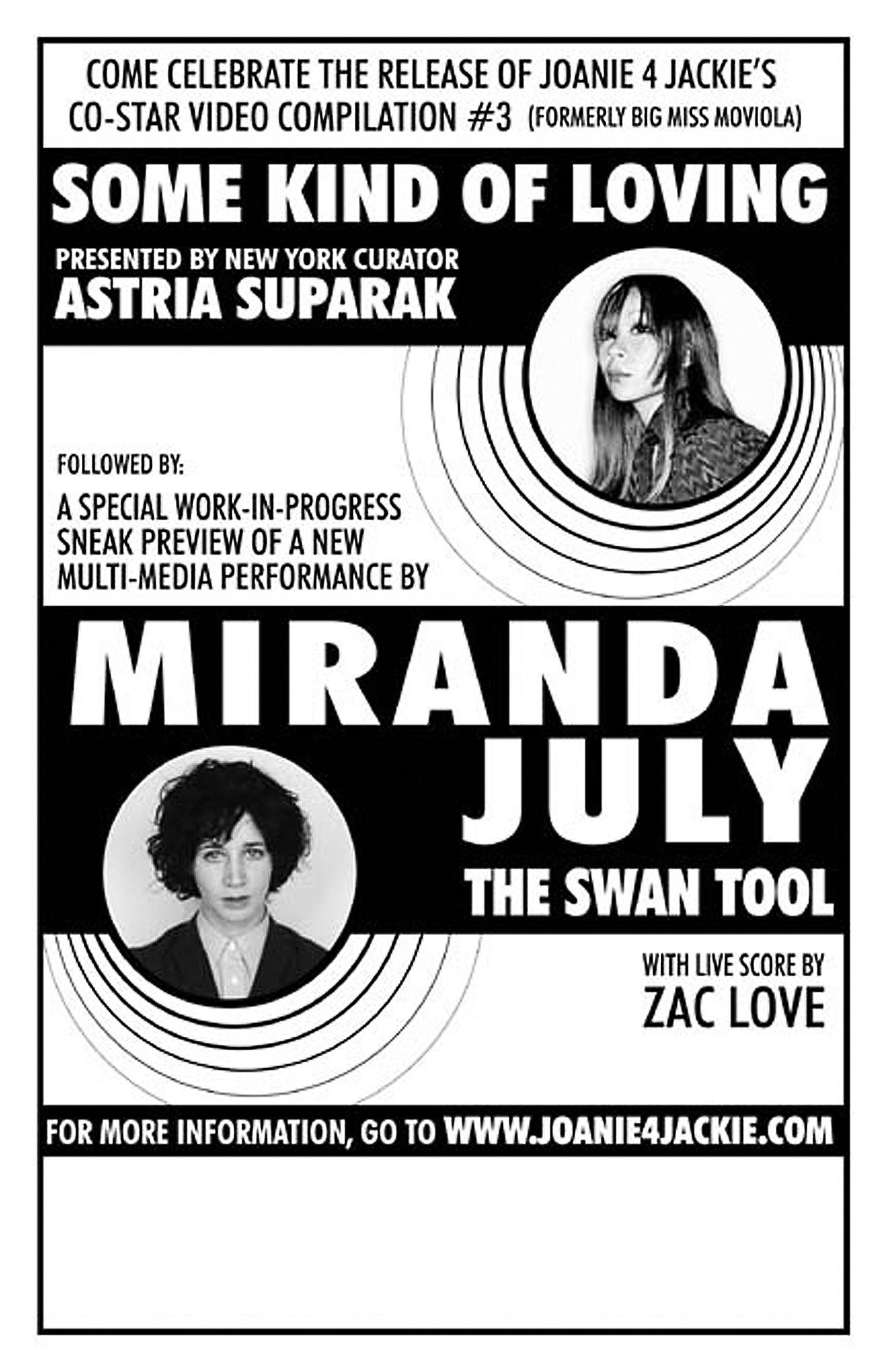
Tour poster for the Some Kind of Loving release with Astria Suparak and The Swan Tool with Miranda July and Zac Love. Xeroxed flier, 2000, 17 x 24″. Designed by Miranda July and Sean Tejaratchi
7—List of Some Kind of Loving Tour Dates, 2001
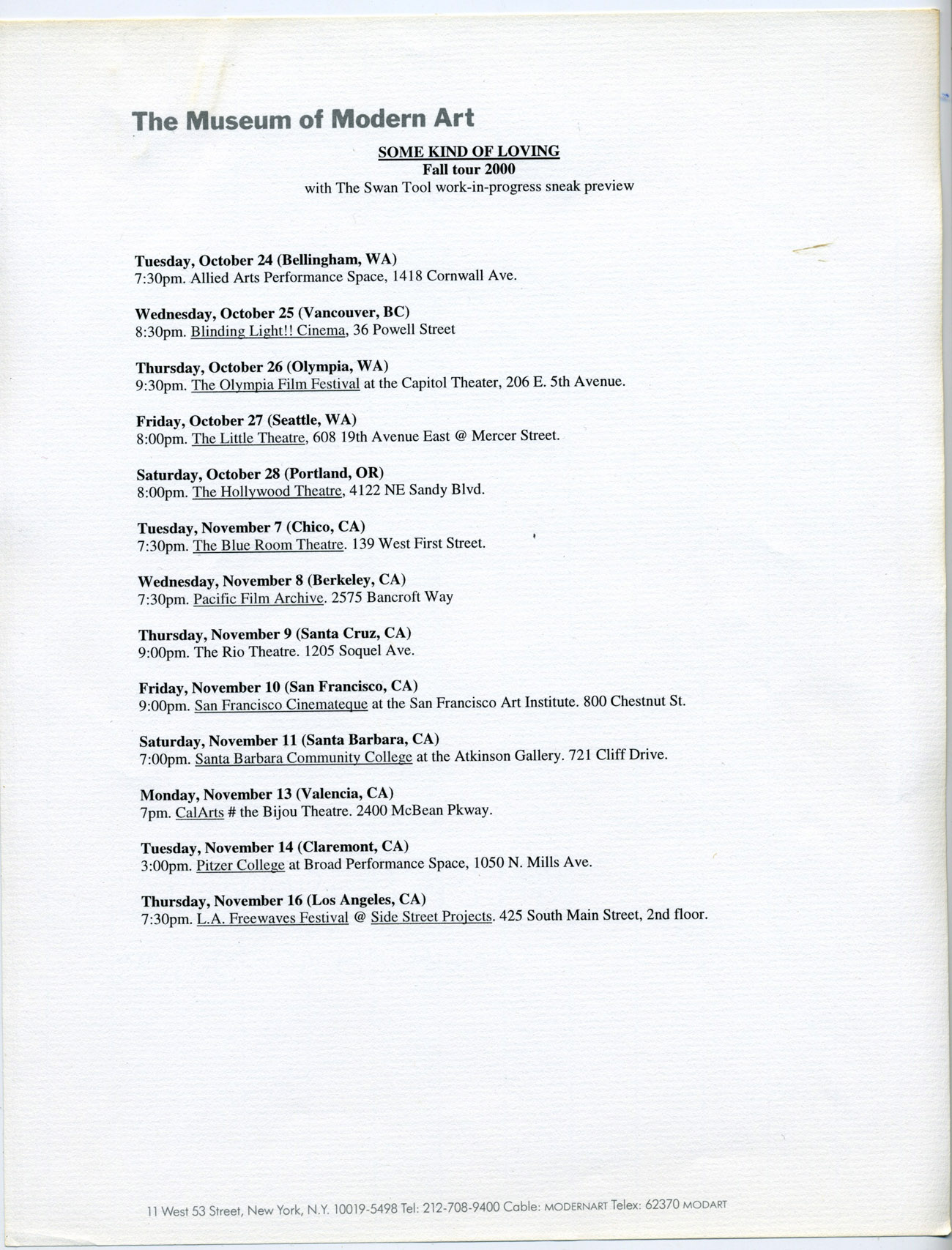
List of Some Kind of Loving tour dates, typed on MoMA letterhead. January 2001. From the collection of Astria Suparak
I was interning at the Museum of Modern Art at this time and “borrowed” some letterhead to draft a post-tour report to the SKL artists, which included copies of all press reviews received. I’m pretty sure I didn’t mail anything on behalf of Joanie 4 Jackie on this letterhead, and was just using the office printer after-hours. Pretty sure.
8—Notes for Some Kind of Loving Tape Sales, 2002

Notes about Some Kind of Loving tape sales and distribution, written by Astria Suparak. August 2, 2002. From the collection of Astria Suparak
This is a list of some of the places I pitched and distributed Some Kind of Loving tapes to, including Printed Matter, The Whitney Museum, and The New Museum (“New Mus”). I usually submitted a tape and press packet (with covers hand-drawn in gold marker) in person, and once accepted, would call or email every few months to check on what sold, when I could pick up my check, and whether more stock was needed. Listed are prices (wholesale and retail) and sales numbers. At the top is a list of people I exchanged tapes with, usually for artwork or meals, including friends, family members, lovers, performance artist Penny Arcade and filmmaker Sam Green.
9—Poster for Alien She, 2013
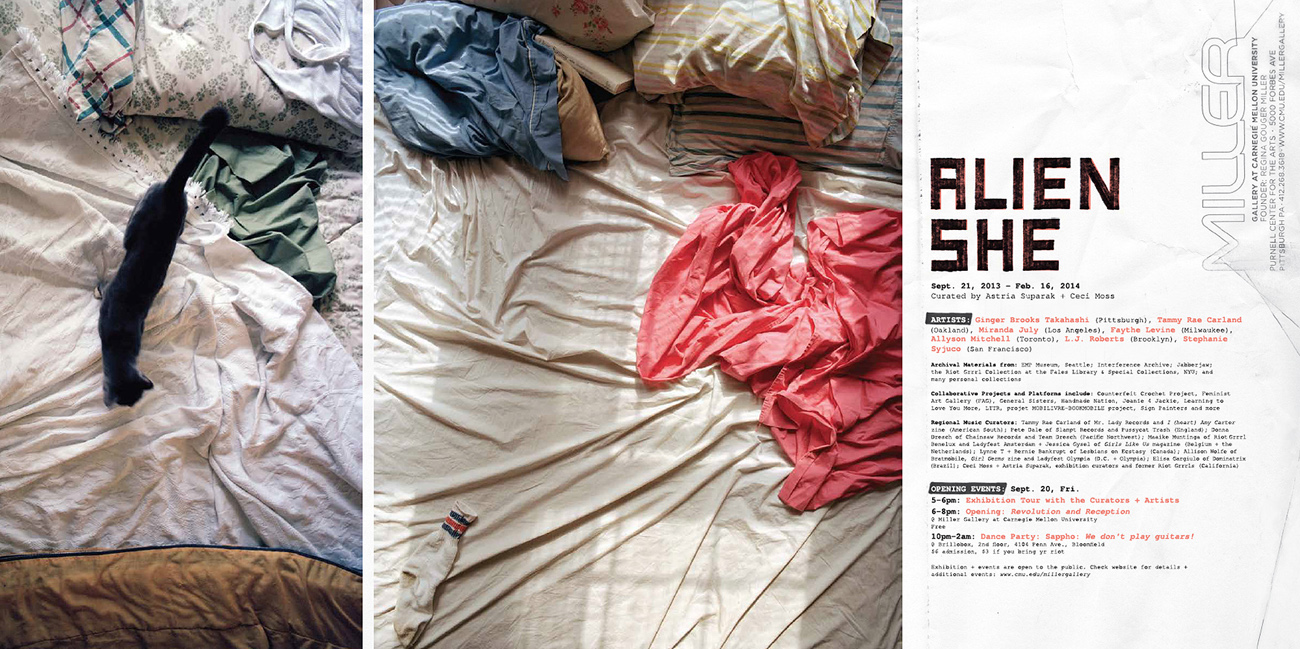
Poster for Alien She, curated by Astria Suparak and Ceci Moss. Color poster, 2013. Designed by Margaret Cox
Alien She was an exhibition I co-curated with Ceci Moss, on the impact of the punk feminist movement Riot Grrrl on contemporary artists. Many of the projects in Alien She attested to the artists’ long histories of nurturing alternative communities and creating information sharing networks, such as the alternative film network Joanie 4 Jackie, created by Miranda July, and FREE TEXTS by Stephanie Syjuco, which freely distributed copyrighted critical texts.


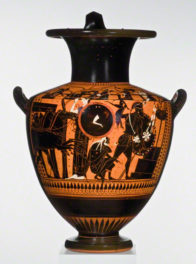


Comments on this post are now closed.